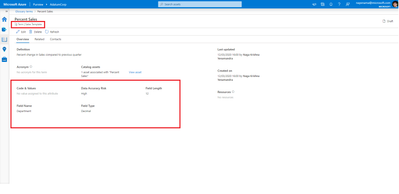This post has been republished via RSS; it originally appeared at: New blog articles in Microsoft Tech Community.
A glossary consists of business terms which allows data consumers from different lines of businesses to have a shared understanding of the data they interact with. With Azure Purview, data stewards can curate data assets discovered in the Azure Purview Data Map. They can then standardize the definitions of commonly used terms using business glossary in Azure Purview Data Catalog. Let's dive into how we make this happen at scale:
1. Concepts - Terms, Term Templates and Custom attributes.
The heart of the business glossary is business term. A term in the Azure Purview Data Catalog business glossary represents a business entity (or process) in an organization. It is highly likely that there are multiple terms representing the same business entity. For example, "customer" = client or purchaser or buyer depending on the business context. Additionally, some terms can inherently have multiple meanings - for eg: API is both Application Programming Interface and Active Pharmaceutical Ingredient! Azure Purview renders distinct meaning to data by defining relationships between terms using related terms and synonyms. It also provides a set of system attributes to define the business term. Finally, data stewards can create custom attributes and templatize terms thus helping customers to contextualize data for easier interpretation.
Azure Purview Data Catalog business glossary also provides flexibility to create custom attributes, logically group them together and attach the same to a term to enrich it's definition. For example, all finance- related custom attributes like cost center, profit center, accounting code can be grouped in a term template called Finance Template and the Finance template can be used to create financial glossary terms. Learn more about custom attributes and term templates here.
Figure 1: Screenshot showing term template and custom attributes for a term.
2. Role definitions
- Data Curators can create/update/delete glossary terms as well as assign terms to data assets and schemas.
- Data readers can view the glossary terms in Azure Purview.
- Data consumers can refer glossary terms and definitions in the Azure Purview Data Catalog
3. Mapping data to business glossary.
Glossary terms can be associated with data entities such as database tables and files as well as to schemas like table columns to provide a business context to the data object. There can be more than one glossary term assoicated to a data object.
Figure 2 : Screenshot showing number of assets associated with a glossary term.
4.Business Glosssary to facilitate semantic search.
Azure Purview supports the discovery of tables and files using glossary terms. A business analyst can search with terms they understand, such as ‘Sales’ to discover relevant sales data. At the same time, technical data analysts can use terms like 'Q4 Revenue' to find the data they need. Further more, glossary terms can be used to narrow down search results to discover data.
Figure 3 : Screenshot showing search result page filtered by a glossary term..
Note: While classifications define the nature of data in the data asset/schema glossary terms vocabulary for an organization and helps in bridging the gap between various departments in your company.
5.Import glossary terms.
Creating or updating each term is a time-consuming process. Hence Azure Purview provides the ability to bulk create/update glossary terms using a .csv file. All the terms in the csv file should belong to the same term template.
The Azure Purview also provides a sample .csv file per template which can be used as reference to import your terms into your Glossary.
Figure 4: Screenshot showing Import terms icon in Azure Purview business glossary.
6.Export glossary terms.
Like Import, Azure Purview also provides the ability to download glossary terms into a .csv file. All the glossary terms selected for export should belong to same term template.
Figure 5: Screenshot showing Export terms icon in Azure Purview business glossary.
Get started today!
We are looking forward to hearing, how Azure Purview helped unlock the potential of your organizations data using business glossary experiences.
- Create an Azure Purview account now and start understanding your data supply chain from raw data to business insights with free scanning for all your SQL Server on-premises and Power BI online
- Use the tutorials to scan and catalog your organization data
- Get an overview of business glossary.
- Go through how-to-guides to create, import and export glossary terms, manage term templates and bulk edit assets to tag glossary terms.
- Use the tutorials document to setup glossary terms in Azure Purview
- Start a conversation on the Azure Purview tech community.






